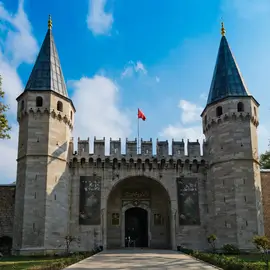When you step into Topkapi Palace, you’re not just walking through a museum—you’re entering the epicenter of a 600-year empire. Located in the heart of Istanbul’s historic peninsula, this sprawling complex was once home to Ottoman sultans, royal concubines, grand viziers, and soldiers. Today, it stands as a magnificent window into the power, culture, and daily life of one of history’s greatest empires.
Whether you’re a history enthusiast or a curious traveler, Topkapi Palace is a must-visit experience that blends architectural beauty, priceless artifacts, and panoramic views of the Bosphorus.
🕰️ A Brief History of Topkapi Palace
Topkapi Palace (Turkish: Topkapı Sarayı) was commissioned by Sultan Mehmed II, also known as Mehmed the Conqueror, shortly after he captured Constantinople in 1453. Built between 1460 and 1478, the palace served as the primary residence and administrative headquarters of the Ottoman sultans for nearly 400 years.
During its prime, the palace was more than a royal home—it was the beating heart of the empire. Everything from military planning to royal ceremonies and religious practices happened within its walls.
In 1924, after the fall of the Ottoman Empire and the establishment of the Turkish Republic, Topkapi was transformed into a museum. It remains one of Turkey’s most visited and revered historical sites.
🧭 What to See Inside Topkapi Palace
The palace is vast—more like a city within a city—so it helps to know what to look for. It’s divided into four main courtyards and multiple pavilions, each with unique historical significance.
1. The First Courtyard: The Imperial Gateway
Your journey starts at the Imperial Gate (Bab-ı Hümayun), a towering entrance leading into the outer courtyard. This space was open to anyone and once housed a hospital, bakery, and stables.
Don’t miss the Hagia Irene Church, one of the oldest Christian buildings in Istanbul, tucked away here.
2. The Second Courtyard: The Administrative Heart
Enter through the Gate of Salutation to reach the second courtyard, where official matters were conducted.
Key attractions:
- Divan (Imperial Council Hall): Where grand viziers and military leaders held meetings.
- Palace Kitchens: Home to the sultans’ massive cooking operations and now a museum with one of the world’s finest porcelain collections.
3. The Harem: Life Behind the Veil
A separate ticket gives you access to the Harem, perhaps the most fascinating part of the palace. This private area housed the sultan’s mother, wives, concubines, and eunuchs.
The Harem features:
- Lavishly tiled chambers
- Gold-plated fireplaces
- Courtyards and fountains
- The Queen Mother’s apartments (Valide Sultan)
This section gives you a rare glimpse into the secretive and hierarchical domestic life of the royal family.
4. The Third Courtyard: Royal Private Quarters
This serene inner court contains:
- Audience Chamber: Where foreign diplomats were received by the sultan.
- Library of Ahmed III: A masterpiece of Ottoman interior design.
- Sacred Trusts Pavilion: Housing Islamic relics, including the Prophet Muhammad’s mantle, sword, and other revered artifacts.
5. The Fourth Courtyard: Garden of Paradise
Finally, the fourth courtyard is a peaceful garden terrace with sweeping views of the Bosphorus and Golden Horn. It’s also home to elegant kiosks like:
- Baghdad Pavilion
- Iftar Pavilion
- Circumcision Room
These spaces were used for leisure, dining, and family celebrations.
🗓️ Visiting Information (2025)
- Opening Hours:
- April to October: 09:00–18:00
- November to March: 09:00–16:45
- Closed on: Tuesdays and the first day of religious holidays
- Tickets:
- Palace Entrance: ~650 TRY
- Harem Section (optional): ~350 TRY
- Museum Pass Istanbul: Accepted
🎟️ Tips for Your Visit
- Arrive early to avoid crowds, especially for the Harem.
- Consider a guided tour or audio guide for deeper historical context.
- Dress respectfully, especially in religious sections like the Sacred Relics Pavilion.
- Allow at least 2–3 hours to explore fully.
📸 Best Photo Spots
- Outer Courtyard Fountain
- Bosphorus-facing terraces
- Tile work inside the Harem
- Gate of Felicity (third courtyard)
🌍 Why Topkapi Palace Still Matters
Topkapi isn’t just a palace—it’s a living museum of empire, faith, and art. Walking its corridors, you’ll feel the echoes of sultans plotting diplomacy, concubines whispering behind carved screens, and imams reciting prayers beside sacred relics.
For those looking to understand Istanbul’s layered history, Topkapi Palace is the ultimate starting point.



















